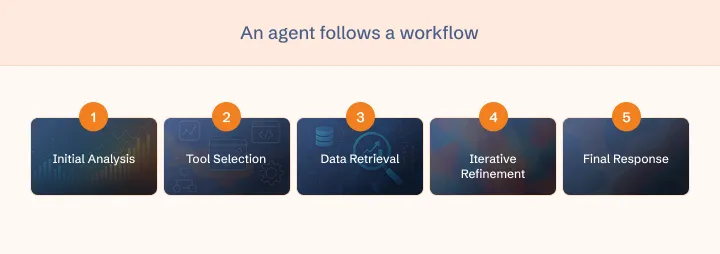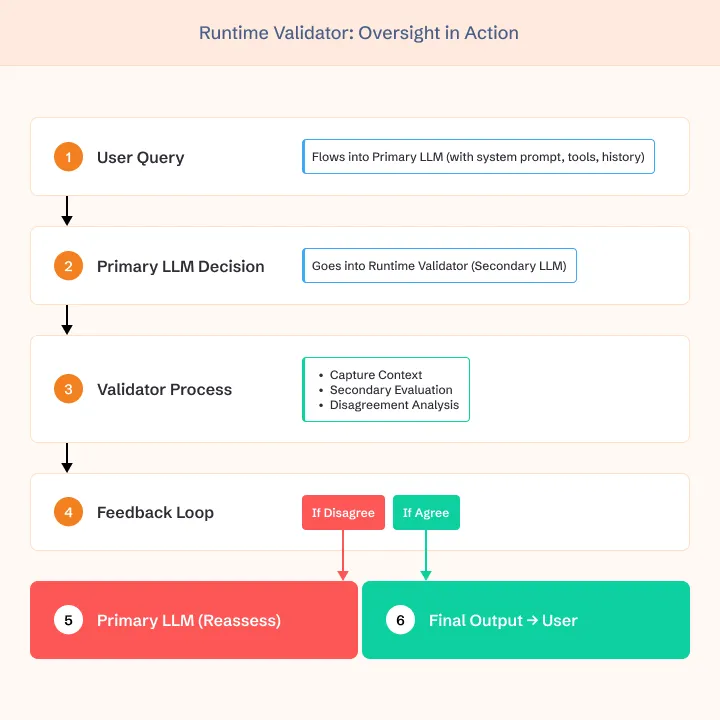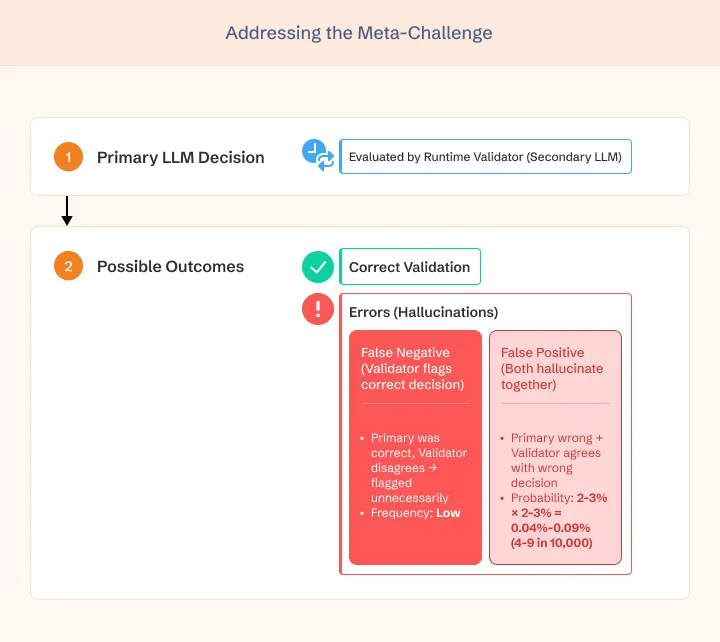Author:
AI hallucinations are one of the most persistent challenges in deploying large language models (LLMs) in production. Even with strong architectures and testing pipelines, errors can creep in, especially when chatbots interact with real-world data over multiple turns.
At Ignite, we’ve been working on ways to make AI more trustworthy in production. Building on our earlier work in automated QA testing, we’ve developed a new layer of defense: the Runtime Validator.
Think of it as an AI-powered safety net, a mechanism that uses the LLM-as-a-judge paradigm to validate every decision your chatbot makes in real time.
To appreciate why runtime validation is necessary, let’s first look at how our agentic chatbot operates.
Unlike static chatbots, our system doesn’t rely only on its pretraining. It uses the agentic tools paradigm.
The chatbot has access to a curated set of tools.
When a user submits a query, our agent follows this workflow:
This workflow ensures efficiency (only fetching what’s needed) while keeping answers grounded in real-time information.


In single interactions, hallucination rates hover around 2-3% (as discussed in the AI Evals and Test Automation blog). But multi-turn workflows introduce compounding risk. Each decision point, tool selection, argument specification, and data interpretation, presents an opportunity for hallucination.
Tool Selection Errors: While often self-correcting (incorrect tools typically return obviously irrelevant data), these errors become problematic when tools return similar-looking but incorrect data.
Argument Specification Errors: Incorrect parameter values can lead to subtly wrong data that may not be immediately recognizable as erroneous.
Resource Waste: Even when the system eventually course-corrects, incorrect decisions consume valuable time and computational resources.


That’s where the Runtime Validator comes in. It acts as a real-time evaluator of the primary LLM’s decisions.
Here’s how it works step by step:
This creates a self-checking mechanism, where errors are caught (and often corrected) before reaching the user.
The Runtime Validator provides value in two critical ways:
Of course, the validator is also an LLM, and it can hallucinate too.
Here’s what we’ve found in testing:
Our Runtime Validator faces the same fundamental limitation as the system it evaluates; it, too, can hallucinate. However, our analysis reveals encouraging patterns:


The Runtime Validator essentially doubles both the LLM cost and response time, as a secondary validation call follows each primary LLM call. However, the value proposition varies by use case:
During development, the Runtime Validator serves as an invaluable diagnostic tool. The cost is justified by:
For production use, organizations must balance cost and latency against error reduction requirements. Considerations include:
The Runtime Validator isn’t standalone; it complements our Gen AI-powered QA Agent:
Together, they create a comprehensive QA pipeline for both development and deployment.
AI systems are becoming more complex and more mission-critical. That means error tolerance is shrinking.
Our Runtime Validator is just the beginning of a new frontier in AI reliability:
We’re excited to continue exploring these possibilities and to help organizations build AI systems they can genuinely trust.
Too many AI initiatives stall because of one recurring challenge: reliability. At Ignite Solutions, we tackle this head-on by building systems that are designed to perform under real-world conditions, where data changes, workflows stretch across multiple turns, and every decision matters.
With our Gen AI-powered QA Agent and Runtime Validator, we’ve created a framework that not only detects and reduces hallucinations but also strengthens overall system performance.
If your organization is looking to move from experimentation to dependable deployment, Ignite can help you design, test, and launch AI solutions that your teams and customers can genuinely trust.
AI hallucinations occur when a chatbot generates responses that sound correct but are factually inaccurate or irrelevant. They happen because large language models (LLMs) generate text based on patterns in training data rather than verified knowledge. Without a grounding in real-time data, they may confidently produce misleading or fabricated answers.
In single-turn queries, hallucination rates are relatively low. But in multi-turn workflows, each step, like tool selection, parameter passing, and data interpretation, adds potential error points. These errors can stack up, increasing the chances of the chatbot drifting into incorrect responses over several exchanges.t.
Runtime validation is a quality control layer that checks chatbot decisions in real time. It uses a secondary LLM to evaluate whether the primary model’s choices, such as tool usage or data interpretation, are logical and accurate before delivering a final answer to the user.
The runtime validator acts like a safety net. It reviews each decision made by the primary LLM, compares it against context (user query, available tools, prior outputs), and flags mistakes. If it disagrees, the validator provides reasoning, giving the chatbot a chance to revise its answer. This feedback loop significantly reduces errors reaching end users.
Yes, since the validator is also an LLM, it can hallucinate. However, the chance of both the primary chatbot and the validator hallucinating in the same way is statistically negligible. For example, with a 1% hallucination rate per model, dual failure probability is about 0.01% (one in 10,000).
Other standard mitigation methods include:
Human-in-the-loop validation: Adds oversight for high-stakes use cases.
Runtime validation is part of a layered reliability framework. During development, automated QA agents test workflows and surface weak points. In production, the runtime validator continuously checks live decisions. Together, they form an end-to-end quality pipeline that makes AI systems more dependable in real-world use.